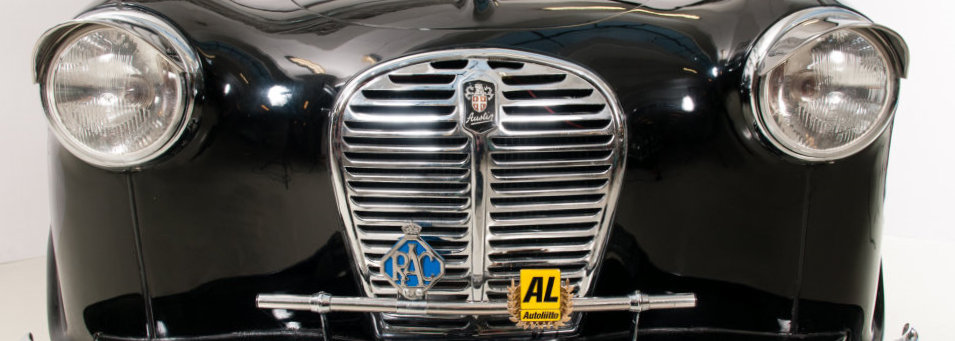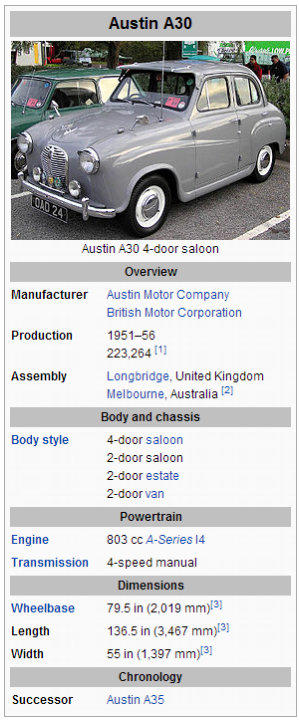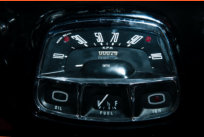



Known as “Puukenkä” (a wooden shoe) in Finland

Austin A30 - 54
The
Austin
A30
is
a
compact
economy
car
launched
at
the
1951
Earls
Court
Motor
Show,
London
by
the
Austin
Motor
Company
and
produced
by
the
newly
formed
British
Motor
Corporation
from
May
1952
to
September
1956.
Introduced
as
the
"New
Austin
Seven",
it
was
Austin's
answer to the Morris Minor.
At launch the car cost £507, undercutting the Minor by £62.Styling
Though Austin had previously contracted the American industrial designer, Raymond Loewy in the task, the designs of Holden 'Bob' Koto were discarded and the car we know was eventually styled in-house by Ricardo 'Dick' Burzi.Features
The body structure was designed by T.K. Garrett, who had been an aeronautical engineer before joining Austin. It was of fully stressed monocoque chassis-less construction, which made it lighter and stiffer than most contemporary vehicles, the first Austin to be made in this way. Inside there were individual seats at the front and a bench at the rear covered in PVC with an option of leather facings on the seats. Evidence of economy was seen in only having a single windscreen wiper, central combined stop/tail/numberplate lamp and a sun visor in front of the driver only. A passenger-side wiper and sun visor, and a heater were available as optional extras. Originally only offered as a 4-door saloon, 2-door variants were introduced in late 1953, and in 1954 a van and van-based "countryman" estate were made available. Despite having a smaller loading capacity than the equivalent BMC O-type Minor based vans (60 cu ft / 1.70 m3 as opposed to 76 cu ft / 2.15 m3) the Austin van offered the same payload. Being slightly lighter and stiffer, it was favoured by businessmen, and saw long service for many. The A30 was replaced by the Austin A35 in 1956 with 223,264 examples having been built. The A30 had a smaller rear window than the A35 and trafficators instead of modern indicators, which popped out from the B pillar when operated by a knob mounted on the centre of the dashboard. The car, along with the larger engined (and hence faster) A35, was quite successful in 1950s saloon car racing, and some still appear in historic events.Performance
The car's newly designed A-Series straight-4 engine was state of the art for the time and returned an average fuel consumption of 42 mpg / under 7L/100 km. With spirited driving the A30 was able to attain a top speed of 70 mph (110 km/h) (factory quoted). In their road test The Motor magazine achieved a top speed of 67.2 mph (108.1 km/h) and a 0–60 mph time of 42.3 seconds. Braking was effected by a hybrid system, with Lockheed fully hydraulic drum brakes at the front and a body mounted single cylinder operating rods to the wheels at the rear, which despite being heavily criticised as being archaic and old-fashioned, were reported as being quite acceptable. The rod system provided good handbrake efficiency and was applied by a lever in an unorthodox position to the right of the drivers seat (Right hand drive vehicles). Bumps were handled by independent coil springs at the front end and beam axle/semi-elliptic leaf springs at the back. A car tested by The Motor magazine in 1952 had a top speed of 62 mph (100 km/h) and could accelerate from 0–50 mph (80 km/h) in 29 seconds. A fuel consumption of 38.8 miles per imperial gallon (7.28 L/100 km; 32.3 mpg-US) was recorded. The test car cost £553 including taxes. The optional radio was an extra £43 and the heater £9. Performance data need to be seen in the context of fuel availability. Early in the Second World War "branded fuel" disappeared from sale in the UK, and the nationally available fuel available at the beginning of 1952 had an octane rating of just 70, which enforced relatively low compression ratios: this reduced the performance available from all cars, especially small ones. In 1952 branded fuels returned to the forecourts, available octane ratings began to increase, and compression ratios were progressively improved along with the performance figures of cars such as the Austin A30 and its A35 successor.Australian production
The A30 was produced in Australia by the Austin Motor Company (Australia) Pty Ltd from 1952 to 1954 and by its successor, the British Motor Corporation (Australia) Pty Ltd from 1954 to 1956.
1954
Engine 803 cc 4 cylinders Power 30 HP


Photos mainly by Matti Kreivilä. Historical facts and technical details of the vehicles provided by Wikipedia. Movies YouTube.



- Decade of 60's
- Austin 850 Pickup - 1962
- Chaika Tshaika 13 GAZ - 1962
- Citroen 2CV - 1961
- DKW Junior - 1961
- Fiat 1100 - 1963
- Ford Taunus 12M - 1961
- GLAS 1204 - 1963
- MG 1100 - 1964
- Moskvich 407 - 1961
- Nagetusch caravan - 1961
- NSU Printz 4 - 1961
- Opel Kadett A - 1964
- Panhard PL17 - 1961
- Peugeot 404 - 1962
- Renault Dauphine - 1965
- Simca Aronde P60 - 1960
- Simca 1000 - 1966














